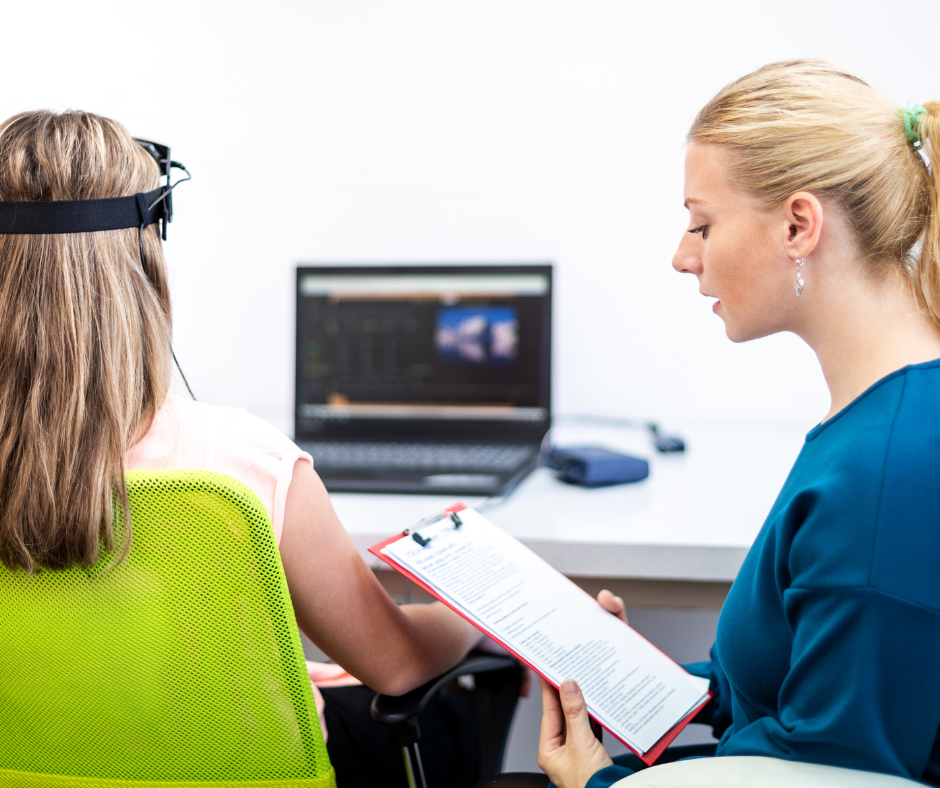In Person:
160 Christian Street, Oxford, CT 06478
Online Therapy:
Connecticut, Maryland, Virginia Florida. HIPAA. Secure Video. Convenient.
Call: 802-578-3700 or Email: connect@mindbodywelltherapy.com
A holistic counseling practice offering ketamine-assisted psychotherapy & neurofeedback brain training
160 Christian Street, Oxford, CT 06478
Connecticut, Maryland, Virginia Florida. HIPAA. Secure Video. Convenient.
Call: 802-578-3700 or Email: connect@mindbodywelltherapy.com
EEG Brain Training created 7-26-24 ~ Written by Lucrezia Mangione, LPC, LCPC, NCC, BC-TMH, DCEP
EEG brain training is exercise for your brain that can potentially help you shift to the next level of better mental health. It is a complement to holistic psychotherapy and counseling and can enhance its benefits. EEG brain training can be a powerful ally on your journey to better mental health and wellness.
There is positive evidence for its effectiveness in improving the treatment of anxiety, depression, ADHD, insomnia, PTSD, and more. And this evidence is still growing. It's not a magic cure-all, however, and it's not for everyone. When it is therapeutically warranted and a good match for the person receiving therapy, it can be a robust tool that opens possibilities within their mental health journey, which may increase the potential of crossing the finish line of their goals.
Read on for an overview of the basics of EEG Brain Training. Click on the links below for more specific details.
 TAI Images, 2024
TAI Images, 2024EEG Brain Training is also known as Neurofeedback, EEG Biofeedback, and Neurotherapy. It is a safe, non-drug, non-invasive technique that exercises your brain—said another way, it trains your brain. The aim of brain training is to help you learn to regulate your brain activity. You can learn how to regulate yourself by receiving “feedback” during a session. This “feedback” is real-time information on your brain activity. In other words, you’re watching your brain activity, and your brain learns new patterns that make it function better.
Over time, it's been shown to enhance the brain's health. In turn, this impacts the symptoms related to certain mental health disorders. It generally supports improvements in psychological, mental, and emotional well-being. EEG brain training is a gentle method of training that works with your brain and body's natural way of being. It is a secure and safe approach that complements mental health.
EEG brain training is a straightforward learning technique that uses a device. EEG stands for an electroencephalogram. This device monitors your brain's electrical signals, which are also known as brainwaves or brain activity. An EEG sends your brain signals to a screen which you can observe. This is called "feedback." This feedback helps you and your brain understand your brain's activity patterns. Said another way, it’s your habits of thinking and feeling and experiencing life around you and within you. While you watch the screen, your brain learns how to change them. And your brain, in its wisdom, will only change them if it feels good.
Do you remember when you were in school and were really interested in a subject? Are you passionate about a topic or have a hobby you love? Think about it right now. Remember how it feels. Feel that good feeling bubbling up? This is the essence of how the brain changes and moves to healthier patterns using neurofeedback. Often, it’s not as dramatic from session to session. But over time, the rain on the windshield of your life can potentially diminish, allowing for clarity to emerge. And life can feel different.
EEG Brain Training is an exercise for your brain that builds mental muscle. Just like a healthy diet, proper hydration, good sleep, and regular exercise all positively impact your mental health and other aspects of your holistic well-being, so does exercising your brain. EEG brain training is like having a personal trainer for your brain that guides and offers a path towards more potential in improving your mental health and well-being.
Learn more answers to the question, What is Neurofeedback treatment? here.

You sit in front of a computer screen, and small sensors are placed on your scalp. These sensors are connected to a computer and an EEG device. During the session, the sensors listen to your brain's electrical signals. Similar to putting your hands on the hood of a parked, running car, the sensors pick up your brain’s vibrations. The sensors feed your brain's activity to a computer. The computer then displays these signals, your brainwaves, on a screen. Both you and your neuro therapist can see your beautiful brain waves in real time.
During the session, the computer provides feedback to you when your brain learns a new pattern that it likes. Depending on the device used, this feedback speaks to or cues three of your senses: sight, hearing, and touch. The cues are visual, like light or movement on a screen; auditory, like sounds; or tactile, like vibrations.
Often, these cues are displayed in the form of a game. For example, you might see a character move when your brain reaches a calmer state. And you might see the same character slow down or stop when your brain is not experiencing calm. This real-time feedback helps you and your brain understand your brain's habits and learn how to change them.
EEG brain training has been researched since the 1960s. Sometimes, it’s been researched using different names, such as Neurofeedback, EEG Biofeedback, Biofeedback EEG, Brain Biofeedback, and Neurotherapy. Numerous studies have shown that Neurofeedback helps manage the symptoms of ADHD, anxiety, depression, pain, and other conditions.
For example, it’s been shown to improve attention and help reduce impulsive behaviors. Studies also show that individuals with anxiety can learn to change their brain waves and grow into a more relaxed state, and those with depression can improve their mood.
Exercising the brain with
EEG brain training and assisting a client in cultivating better control
of how their brain operates can help a person experience:

EEG Brain Training provides benefits for both the non-HSP and HSP alike. In my work with highly sensitive clients, I've observed that sensitive nervous systems respond exceptionally well to this type of work. It could be because of the natural tendency of a highly sensitive person to notice subtle changes in the environment. When those changes elicit a beneficial response, which is the goal of EEG brain training, the sensitive system nervous system says, "Ah, yes. I want more of that.” I’ve also observed that it's been valuable in minimizing or preventing that shift into the dreaded sense of overwhelm and overstimulation. These are anecdotal observations, of course. Here's more about the known benefits based on research and the potential to support you as a highly sensitive person:
By working with your sensitive brain and brain waves, you gently train yourself to experience a more relaxed state in your mind and body. EEG brain training is known to reduce stress and tension and lower anxiety.
Enhanced Emotional Resilience: Improving your sensitive brain's function may help you feel better about yourself as a sensitive person. I’ve heard my clients report a sense of inner balance, stability, and calm. They commonly share, “I feel more like myself.” It may also help you handle life's challenges and stressors more easily.
Better Sleep: EEG Brain training can improve sleep patterns for some. Quality sleep is an essential requirement for overall health and well-being. And it is essential for your mental health. Quality sleep contributes to emotional stability for any human body, including a highly sensitive person.
EEG brain training integrates with other practices and potentially enhances their benefits. For example:
EEG brain training complements therapy well. Here's how they work together. You receive psychotherapy and counseling to help you work through your emotional and psychological challenges, gain insight, and make peace. EEG brain training exercises your brain. Because it supports healthier brain function and emotional regulation and improves the relaxation response, it can help your work in the counseling chair.
Meditation has many benefits and is a no-tech brain training practice in and of itself. Meditation teaches you to be present and aware of yourself in the here and now. The effects received through EEG Brain Training can enhance the practice of meditation. And if you're new to meditation, it may help you achieve a meditative state more quickly. Together, Meditation and EEG Brain Training may make entering a calmer and more focused state easier. Being able to shift your awareness to a more relaxed focus state is an important aspect of what your brain learns from EEG brain training.
Mindfulness is another no-tech brain training technique. Research suggests that an ongoing mindfulness practice can enhance positive brain changes. Neurofeedback supports mindfulness practices such as conscious breathing, body scans, and conscious movement.
Integrating EEG brain training with holistic psychotherapy and counseling can be empowering. Integrating Neurofeedback into a meditation or mindfulness practice creates an opportunity to enhance the benefits of those no-tech brain training practices. EEG brain training can improve these efforts by optimizing your brain's functioning. It combines modern technology, traditional talk therapy, and mental health and wellness practices.

EEG Brain Training alongside holistic psychotherapy and counseling can be a beautiful combination, especially for the empathetic, highly sensitive person. It can be a deeply supportive process that helps deepen your connection to your sensitive nature and embrace your sensitive strengths. It's also an opportunity to nurture yourself and your mental health.
Your mental health journey is uniquely yours. Whether you're looking to overcome overwhelm and overstimulation, reduce anxious feelings and thoughts, feel better about yourself, become more focused, improve your emotional resilience, or help your brain become as healthy as possible, EEG brain training offers new possibilities.
At Mind Body Well Therapy, Pllc, EEG Brain Training and neurofeedback complement the holistic psychotherapy and counseling services our highly sensitive clients receive. Brain training and mental health counseling are a dynamic duo when therapeutically warranted.
Are you already under the care of a therapist or another licensed healthcare provider? AND Are you interested in seeing if Neurofeedback may benefit your therapy? Great. Stay with them. Reach out. Let's talk about how EEG Brain Training may be an add-on to aid in the good work you and your healthcare provider are doing together.
Are you looking for a therapist and wondering whether EEG brain training can support your mental health wellness journey? You’re welcome to schedule a clarity call. Let's see how holistic psychotherapy and EEG Brain Training can serve you.
What is Biofeedback Therapy?
What is Neurofeedback Treatment?
The Difference between Biofeedback and Neurofeedback
Neurofeedback Near Me
Arns, M., de Ridder, S., Strehl, U., Breteler, M., & Coenen, A. (2009). Efficacy of neurofeedback treatment in ADHD: the effects on inattention, impulsivity, and hyperactivity: a meta-analysis. Clinical EEG and neuroscience, 40(3), 180–189. https://doi.org/10.1177/155005940904000311
Askovic, M., Soh, N., Elhindi, J., & Harris, A. W. F. (2023). Neurofeedback for post-traumatic stress disorder: systematic review and meta-analysis of clinical and neurophysiological outcomes. European journal of psychotraumatology, 14(2), 2257435. https://doi.org/10.1080/20008066.2023.2257435
Hammond D. C. (2005). Neurofeedback with anxiety and affective disorders. Child and Adolescent Psychiatric Clinics of North America, 14(1), 105–vii. https://doi.org/10.1016/j.chc.2004.07.008
Lofthouse, N., Arnold, L. E., Hersch, S., Hurt, E., & DeBeus, R. (2012). A review of neurofeedback treatment for pediatric ADHD. Journal of attention disorders, 16(5), 351–372. https://doi.org/10.1177/1087054711427530
TAI Images. (2024). DALL-E 3. [AI image generator]. https://tai.sitesell.com
Thibault, R. T., & Raz, A. (2017). The psychology of Neurofeedback: Clinical intervention even if applied placebo. The American psychologist, 72(7), 679–688. https://doi.org/10.1037/amp0000118
Wu, Y. C., Yu, H. E., Yen, C. F., Yeh, Y. C., Jian, C. R., Lin, C. W., & Lin, I. M. (2024). The effects of swLORETA Z-score Neurofeedback for patients comorbid with major depressive disorder and anxiety symptoms. Journal of Affective Disorders, 350, 340–349. https://doi.org/10.1016/j.jad.2024.01.020
Yue, W. L., Ng, K. K., Koh, A. J., Perini, F., Doshi, K., Zhou, J. H., & Lim, J. (2023). Mindfulness-based therapy improves brain functional network reconfiguration efficiency. Translational psychiatry, 13(1), 345. https://doi.org/10.1038/s41398-023-02642-9
Explore whether holistic therapy, EEG brain training, or KAP ketamine-assisted psychotherapy right for you. Reach out for a no-charge consult.
Lucrezia Mangione works to lift up anxious, highly sensitive women in discovering how to fine-tune their focus and attention, feel shielded from other people’s needs, and discover the strengths of being sensitive so that they stay steady amid the busyness, feel calm and more spacious, have more peace of mind to live and work on their own terms. Lucrezia Mangione is a board
certified licensed professional counselor, board certified telemental
health provider, neurofeedback trainer, KAP ketamine-assisted psychotherapy therapist and approved
counselor supervisor.
She is the owner of Mind Body Well Therapy, Pllc, a private practice.